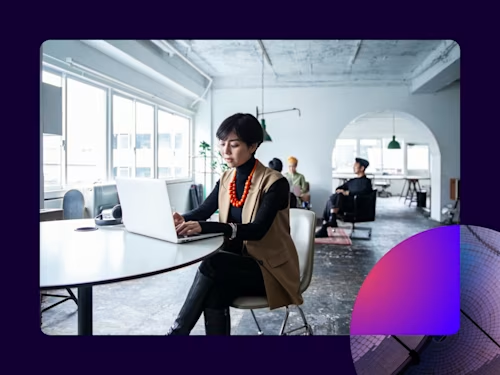
How to Drive End-to-End Business and Contract Management Process Automation at Scale
Contract Management Process is a hot topic going hand in hand with automation. Discover how You can deliver value with end-to-end automation, with Docusign.
- The rise of end-to-end contract management automation—three industry-agnostic trends
- Contract Creation and Contract Management Process
- Remote work is accelerating the digital transformation in contract management
- A strategic rather than tactical approach to lifecycle management and automation
- How to successfully automate at scale
- Automate effortlessly with the Docusign
Table of contents
- The rise of end-to-end contract management automation—three industry-agnostic trends
- Contract Creation and Contract Management Process
- Remote work is accelerating the digital transformation in contract management
- A strategic rather than tactical approach to lifecycle management and automation
- How to successfully automate at scale
- Automate effortlessly with the Docusign

utomation is a buzzword that gets tossed around a lot, but the events of the past year made improving contract management process and automation a critical play for every organisation. As offices migrated en masse to remote work and internal process demands increased, organisations without end-to-end digital automation of their contract lifecycle management were at a severe disadvantage. Without an integrated contract management software solution that connects processes across silos - work slows down, and the customer experience suffers and productivity is lost. If anything is to be learned from the pandemic, it's that strategic end-to-end automation drives consistent process improvement.
In a recent webinar, "Create a Strategy to Drive End-To-End Automation at Scale," Docusign SVP of Engineering Tom Casey and Forrester Research VP Rob Koplowitz discussed the factors driving end-to-end automation at scale—and offered some strategic advice to support your digital transformation.
The rise of end-to-end contract management automation—three industry-agnostic trends
The new drivers of business process automation
Over the last few years, there's been a shift from cost reduction to customer experience as the primary driver of process improvement. In an early 2020 survey conducted by Forrester that sought to assess the top priorities of 954 global business leaders, 'improve customer service' ranked at the top of the list, outpacing the traditional leader, 'reduce operational expenses.' The survey found that there has been some progress toward contract lifecycle management automation but inefficient, manual agreement processes still exist. When asked about their company's priorities for the next year, decision-makers rated the following factors as high or critical priorities:

While COVID-19 changed many things (budgets, ability to travel), top priorities stayed the same. C-level executives still want better ways to prepare for business disruptions and improve the customer experience—while keeping costs at a minimum.
Contract Creation and Contract Management Process
End-to-end automation of the contract management process provides a universal answer to the changes accelerated by the COVID economy. Single-point solutions like electronic signatures and searchable contract repositories helped organisations eliminate operational hurdles while cutting down the time teams must devote to all stages of contract management, including contract creation, contract drafting, sharing, completion and approval of contracts. Remote work made manually signing and sharing documents an impossibility, so adopting new digital solutions was imperative at an enterprise level. Organisations worldwide started to see the far-reaching benefits of automation and implement best practices for contract lifecycle management and electronic signatures.
Remote work is accelerating the digital transformation in contract management
The pressure of a global shift to remote work helped business leaders realise the importance of developing a digital infrastructure to support rapid change in contract management. Working from home introduced many in the business world to new problems almost overnight, but it also forced leadership to quickly come up with new solutions—ones that will have lasting value beyond COVID.
"There were really two patterns that we saw during COVID," says Rob Koplowitz:
Resists automation: The old school business that thinks they can weather inefficiencies. They're slightly concerned from a governance, risk and compliance (GRC) perspective or lack the information needed to move quickly toward digital transformation.
Embraces automation: Companies that are in the midst of digital transformation have already vetted their solutions—but need to move faster.
"Businesses in the first camp struggled mightily," says Koplowitz. As for businesses who already understood the value of automation, he adds: "those organisations—in most instances—were able to move very quickly. We look at this as forcing functions toward the new normal, a standardised approach to automation."
Forrester's Research conducted just before the pandemic demonstrates that the use of ink-to-paper signatures was already rapidly declining towards the end of 2019. "People were over it," Koplowitz summarises. "They don't want to do it the other [manual] way. Enter COVID, and they can't do it the other way."
Still, 77% of businesses have processes that rely on paper. Another 63% of companies depend on desktop tools like email and Excel to manage their document workflows—neither of which delivers real automation. A fully automated system of agreement strategy supports not just customer onboarding but also other contract management workflows (employee onboarding, legal review, procurement, etc.). Even when the world returns to their work offices, a consistent, digital approach across your entire organisation enables you to get the most out of any automated business practice.
A strategic rather than tactical approach to lifecycle management and automation
"The electronic signature is often where folks start," shares Docusign SVP of Engineering Tom Casey. "I think that's wonderful, obviously. But we have also started to step back and think about the Systems of Agreement that businesses have as a whole."
As COVID-19 highlighted, business agility is critical for organisations that wish to survive unanticipated challenges. A reactive approach to automation may keep your head above water, but, in the long run, it can also slow your organisation down. In other words, there's only so much that a single-point solution can do. Developing a proactive strategy for integrating end-to-end automation at scale is vital.
"Sure, automation will always cut costs—but we want to consider the experience. That's what's durable," says Casey. During COVID, short-term fixes on the ground were prioritised over long-term solutions with high-level, lasting impacts. Now, the tide is beginning to shift. The benefits of full-scale lifecycle automation—like better customer experiences, business agility, increased productivity and greater security—are clearer than ever before.
But what does strategic end-to-end automation look like in practice?
How to successfully automate at scale
Automating at scale is both technical science and change management art. For instance, nearly 50% of businesses today claim that they are prepared to invest in an automated, end-to-end contract management solution but don't have the tools or know-how to do it effectively. "The problem is that end-to-end automation requires a lot of technology," says Koplowitz.
"Cobbling together disparate tools does not leave your business more agile." In fact, it solves immediate problems by creating even more significant obstacles down the road. "You have to think strategically about digital transformation—not reactively—to make sure you're applying the right tech in the right place at the right time," adds Koplowitz. So what is the best practice for implementing an end-to-end contract management system?
Effectively preparing for enterprise-wide automation is based on three pillars of change management:
Adaptability: As demonstrated by the fallout of COVID-19, the ability to adopt new business practices or workflows overnight is critical when it comes to surviving unforeseen challenges. An integrated approach to end-to-end automation starts with a contract management platform or lifecycle solution that can adapt and scale with your organisation.
Standardisation: Your processes don't care about organisational boundaries. For technology and people to securely work together across silos, you need a consistent, cross-functional approach to your Systems of Agreement.
Governance: Upper-level management, IT, and GRC teams must work together and actively involve themselves in the implementation and operation of an end-to-end automation solution. Working together helps balance tactical implementation with broader strategy and minimises errors that create risk.
While saving time and cutting costs have always been long-standing drivers of digital transformation, the efficiency of today's digital marketplace is producing consumers who prioritise speed, simplicity and transparency in all aspects of business. Automation at scale meets rising consumer expectations while also providing a path to increased workplace productivity and reduced operational costs.
Automate effortlessly with the Docusign
"Automation is the expression of how your business runs," summarises Rob Koplowitz. From contract generation and management to negotiating and signing, the Docusign Agreement Cloud is a no-code, low-cost solution to digital transformation that makes end-to-end automation your competitive edge. The Docusign Agreement Cloud™ digitally transforms how you do business via contracts and other types of agreements with a suite of application like Docusign CLM, Docusign eSiganture and Docusign Insight that can help your business prepare for the uncertainty of the future.
Related posts
Docusign IAM is the agreement platform your business needs



